The Last Ocean: Saving the Ross Sea
Antarctica is hurling toward a cliff. Over just a few decades, climate change has transformed the very fundamentals of its environment. History proves that we can find the will to act on behalf of Antarctica—now we must find the will, again, to achieve the greatest act of conservation in history. Saving the Ross Sea.
Each 30-foot swell corkscrews the ship into the next wave-on the extremes of the worst rolls, you can walk on the walls as the ship navigates endless silver-black mountains of water. Days farther south, the ocean calms to glass, and a thin white line of ice stretches across the entire southern horizon, splitting sea and sky. As the ship cuts through that line, a jigsaw puzzle of sea ice reaches out to the edge of your imagination. There are no words to describe the scale, the silent power. But this is all just a backdrop—despite its extreme conditions, Antarctica’s ocean teems with life.
In fact, these icy waters support the world’s most productive ecosystem, anchored by shrimp-like Antarctic krill, the most prolific species on Earth. Minke whales and orcas pioneer deep into the ice to hunt the bounty. Adélie penguins explode out of the sea like corks shot from a bottle. Snow petrels dart above, origami birds tossed into the wind.
All Antarctic animals have fantastical stories. Emperor penguins breed in winter, each male holding an egg on their feet as they crèche together in the intense cold. They are the deepest diving birds in the world, reaching depths of nearly 1,800 feet and dive times of 25 minutes. Just before a dive, an emperor pumps its heart up to 250 beats per minute, saturating its body with oxygen. Over the course of a long dive, the bird can slow its heart to just 6 bpm, accelerating back to 250 bpm as it resurfaces. In doing so, the birds replicate the stresses of a human heart attack with each dive. And this is just the view from above water.
As you drop below the ice, shades of cyan replace the veils of white, and there in the blue light, seals sing. Weddell seals live in McMurdo Sound all year long. To pull this off, they must, at times, dive half a mile deep, stay submerged for an hour and a half and eat through the ice to keep their dive holes open in winter. Each encounter bears witness to a masterpiece of evolution—fish that make their own antifreeze, sea spiders the size of dinner plates—each creature supremely adapted to the unimaginable rigors of living in a sea of ice.
All of these wonders are in peril. Dozens of ice shelves— massive floating glaciers, thousands of feet thick—fill in the bays along the Antarctic Peninsula, the continent’s northernmost point.
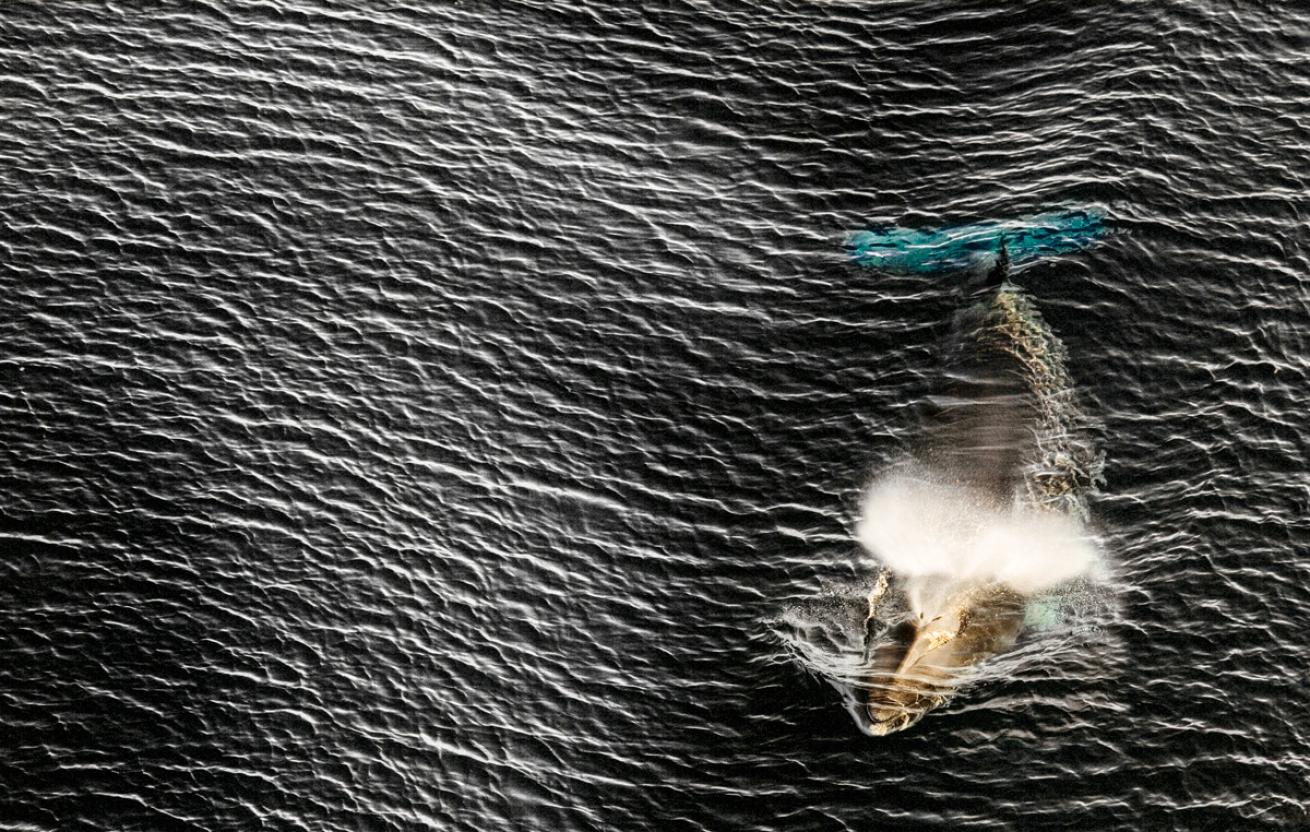
John WellerA minke whale at the surface of Antarctica’s Ross Sea.
Under normal conditions, ice shelves regularly retreat and advance— a stable process for at least the past 10,000 years. Now more than 90 percent of the peninsula’s ice shelves are in rapid retreat. A dozen have collapsed completely, and Antarctica as a whole is melting at an accelerating rate. Maps of Antarctica must be redrawn every year; if trends continue, most coastal cities will be underwater in a few centuries due in large part to that colossal melt.
In the shorter term, the sea ice around the peninsula is forming later and melting earlier each year. Antarctic denizens depend on sea ice, and these changes are devastating. Adélie penguin populations have declined by 65 percent along the peninsula in the past 25 years. Weddell seals, silverfish and krill are also declining. The entire ecosystem is contracting with the ice, squeezed even farther south into regions that have not yet warmed as much. There is not much farther south that they can go.
Melting ice is not the only threat. Every year, the Southern Ocean absorbs a third of all atmospheric CO2, buffering the entire globe from the full force of greenhouse gases. But the more it absorbs, the more acidic it becomes. Calcifying organisms like pteropods are already in danger, unable to form shells in the newly acidic water.
Our exploitation of the Southern Ocean compounds these challenges. Sealers started hunting fur seals for pelts in the 1790s. Many populations collapsed in just 30 years, and the industry turned to elephant seals and penguins for their oil.
Southern Ocean whaling began in the early 1900s. By the time it was banned in the 1980s, only 10 percent of the great whales were left. Most species have never recovered. Finfish fisheries started in the 1960s, crashing a few years later. Krill fishing also started in the 1960s, though the catch was only fit for fish meal. The 1990s brought fisheries for Patagonia toothfish, sold as “Chilean sea bass” and known as “white gold.”
These fisheries were also quickly overexploited, forcing fishers farther south in search of Antarctic toothfish—an even more vulnerable species.
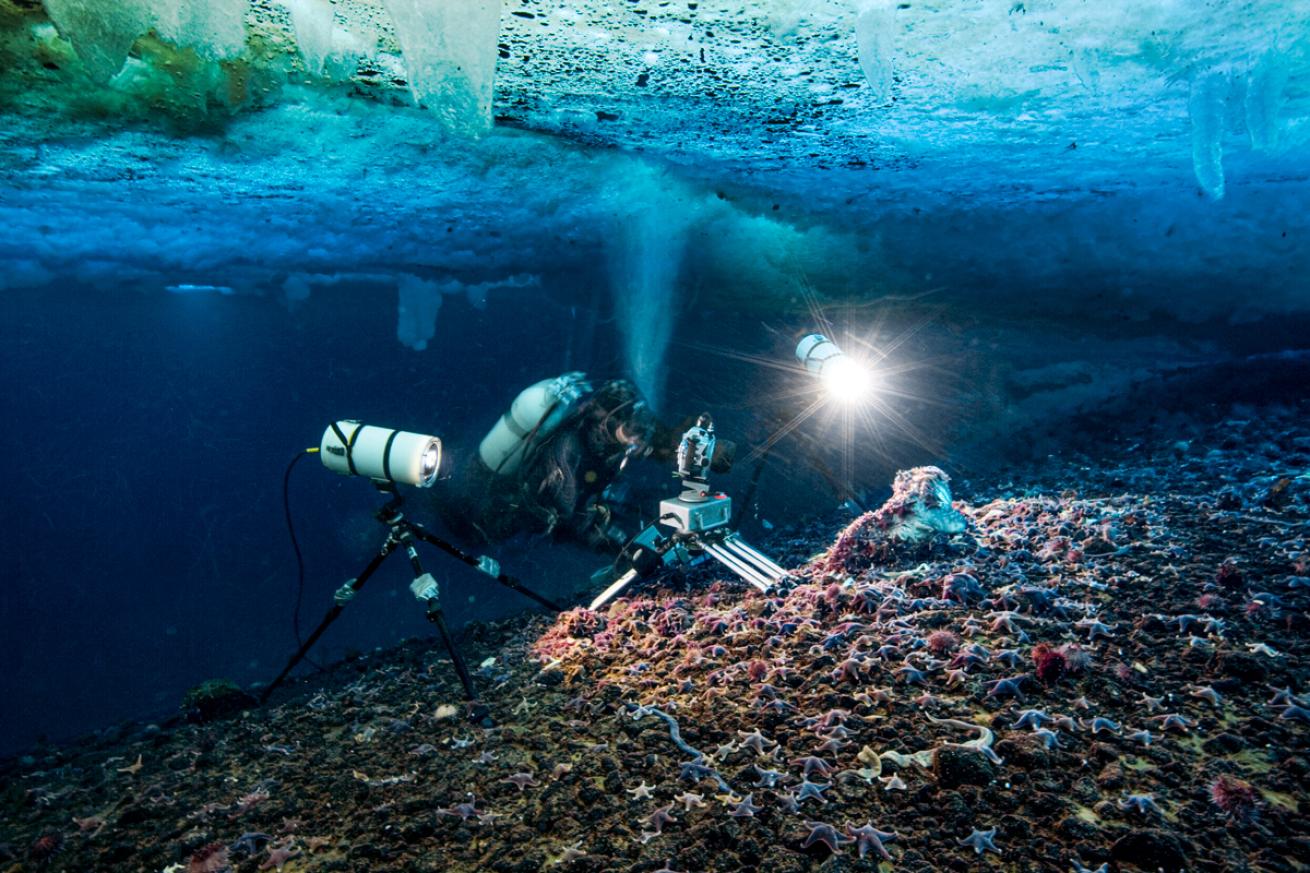
John WellerVideographer Doug Allan films benthic life.
A MAN, A PLAN
I must back up and explain how I have come to devote—thus far—17 years of my life to the vision of Southern Ocean protection, and why I believe it is possible. In 2004, a trusted friend handed me a scientific paper, saying, “This is something everybody needs to read.”
By the end of the document, the pages were heavy in my hands. Antarctic ecologist David Ainley starts by presenting evidence that the Ross Sea, Antarctica, is the last large, intact marine ecosystem, illuminating the shocking assessment by the U.S. National Science Foundation: “Little if any of the ocean remains unaffected by fisheries, agricultural runoff, sewage, aquaculture and industry.” Ainley then demonstrates that a fast-expanding fishery for Antarctic toothfish, the Ross Sea’s largest predatory fish, would cause irreparable harm in this last wild place.
My worldview was upended. At the time, I knew next to nothing about the ocean—I had never been snorkeling, let alone diving— and the thought of one last undamaged place was inconceivable. In my ignorance, I had perceived the ocean to be infinite, a vast wilderness. I was deeply embarrassed.
So, two weeks later I met Ainley. We talked into the night. Catch levels of Ross Sea toothfish were ramping up blindly, even though no one had ever found an egg or larval fish, and no one knew population size or where, when and how often they breed. It was known that the fish lives 50 years and starts breeding in its late teens, making it extremely vulnerable to overfishing. That night, we committed to build a campaign for a marine protected area in the Ross Sea. The 12-year journey would completely transform my life.
I returned to Colorado with an armload of reading, and got to work. Over the next two years, I met with scientists all around the United States and beyond. I sat down with media executives, members of Congress, businesspeople, educators, filmmakers. I collected support from my entire community—family, friends, friends of friends. The community expanded. Legendary underwater photographer Bill Curtsinger graciously gave me a road map so that four years and 600 dives later, I could dive in the Ross Sea. Finally, Quark Expeditions offered me passage on an icebreaker, bringing me, after three years, to the edge of the ice.
But this was just the start.
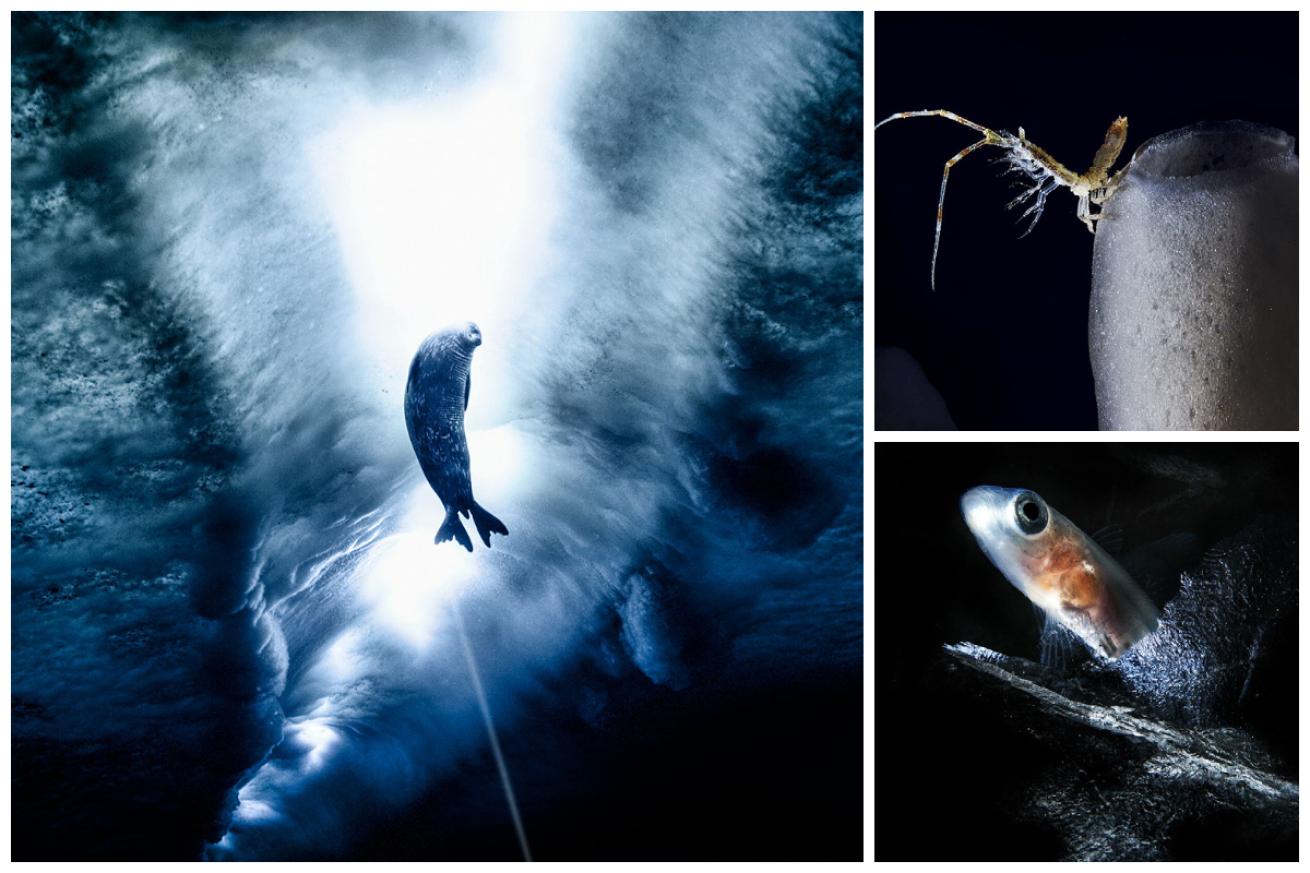
John WellerClockwise from left: Weddell seal; Antarcturus, an Antarctic isopod; Pagothenia borchgrevinki lives in platelet ice.
A MILLION SIGNATURES
Any protection for the Ross Sea would have to come from CCAMLR, the Commission for the Conservation of Antarctic Marine Living Resources, where all decisions must be unanimous. Getting a formal Ross Sea MPA proposal into CCAMLR would be hard enough, but then we would have to persuade 24 countries and the EU to support it. How to do that?
To start, we needed more science to justify an MPA. Ainley and his colleagues worked to demonstrate the importance of the Ross Sea, and the threats. But we needed more. In 2009, I organized a Ross Sea conference and raised money to invite scientists from the U.S. and Europe. The conference resulted in a multidisciplinary paper—the foundation for the Ross Sea MPA design.
The paper led to scientific consensus, gaining the support of more than 500 scientists worldwide. Based on this work, the U.S. became the first national sponsor of a formal proposal in 2010. Representatives from the U.S. began building the diplomatic bridges needed to achieve the goal. The first step had been achieved—a Ross Sea MPA would be discussed on the CCAMLR floor. Concurrently, we needed a public campaign. No organizations were actively working on the Ross Sea when we started. I’ll fast-forward through the years of single-minded pursuit as we slowly built momentum. I recruited New Zealand filmmaker Peter Young, and as a trio with Ainley, the Last Ocean Project began to fully take shape. The Antarctic and Southern Ocean Coalition (ASOC) and the Pew Charitable Trusts were the first to pick up the torch; what followed was the birth of a community, as we entrained the attention of policymakers, organizations and individuals across the globe.
By 2009 I had been to the Ross Sea three times on ships, and once more with the National Science Foundation for three months of diving out of McMurdo Station. Young had joined me for one trip and had flown all over the world following the path of the toothfish from hook to plate. Now with libraries of 160,000 images and 250 hours of film, we set out to tell the story to the public.
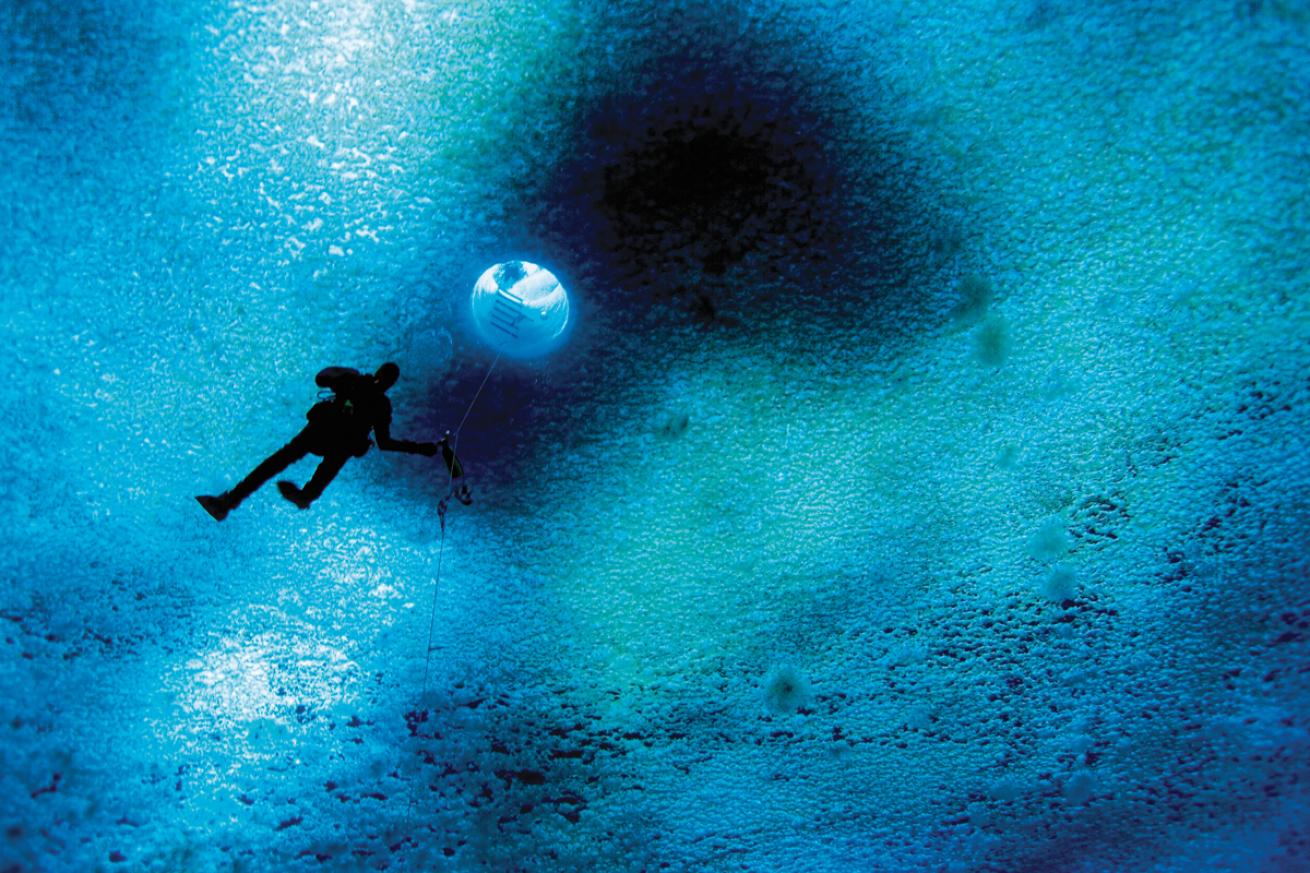
John WellerA diver descends below a hole cut into the ice at Turtle Rock, McMurdo Sound, in Antarctica’s Ross Sea.
The images were published thousands of times, reaching a global audience of close to a billion. Young’s film toured the globe. Diplomats from all CCAMLR nations received my book, The Last Ocean. We spoke directly to CCAMLR delegates and presidents of key nations. Together with our partner organizations, we brought an obscure place into the mainstream. We gave it a face, branded it. By the end, we had a million signatures, the Ross Sea was known as “The Last Ocean”—even on the floor of CCAMLR—and we put CCAMLR on notice that the world was watching.
I wish I could pay homage to all the people and organizations that supported us. There are too many people to mention, too many incredible collaborations. This pursuit brought me my brilliant wife, and eventually our daughter and son, who bear names inspired by the Ross Sea. As we fought to bring the Ross Sea into public view, teams of exceptional and tireless people had started to fight concurrent battles in boardrooms, the media and scientific journals all over the world. Maybe Ainley had started the train. Maybe the train had started on its own. Who knows? But the train was moving. We did our best to hold on and stoke the engines.
A GLOBAL TRIUMPH
But then the train stalled on the tracks. For years, the vision of protecting the last pristine place seemed more and more unlikely. As my faith in the outcome waned, so did my faith in humanity. Then in 2013, we collaborated with Pew to approach U.S. Secretary of State John Kerry. He quickly became determined to make the Ross Sea part of his legacy. The issue even landed on President Barack Obama’s desk. He and Kerry became crucial negotiators for the Ross Sea—one of the last legs of the journey that led to October 28, 2016, when CCAMLR adopted the world’s largest marine protected area, in the Ross Sea. It is the first large-scale international MPA, a triumph of global cooperation.
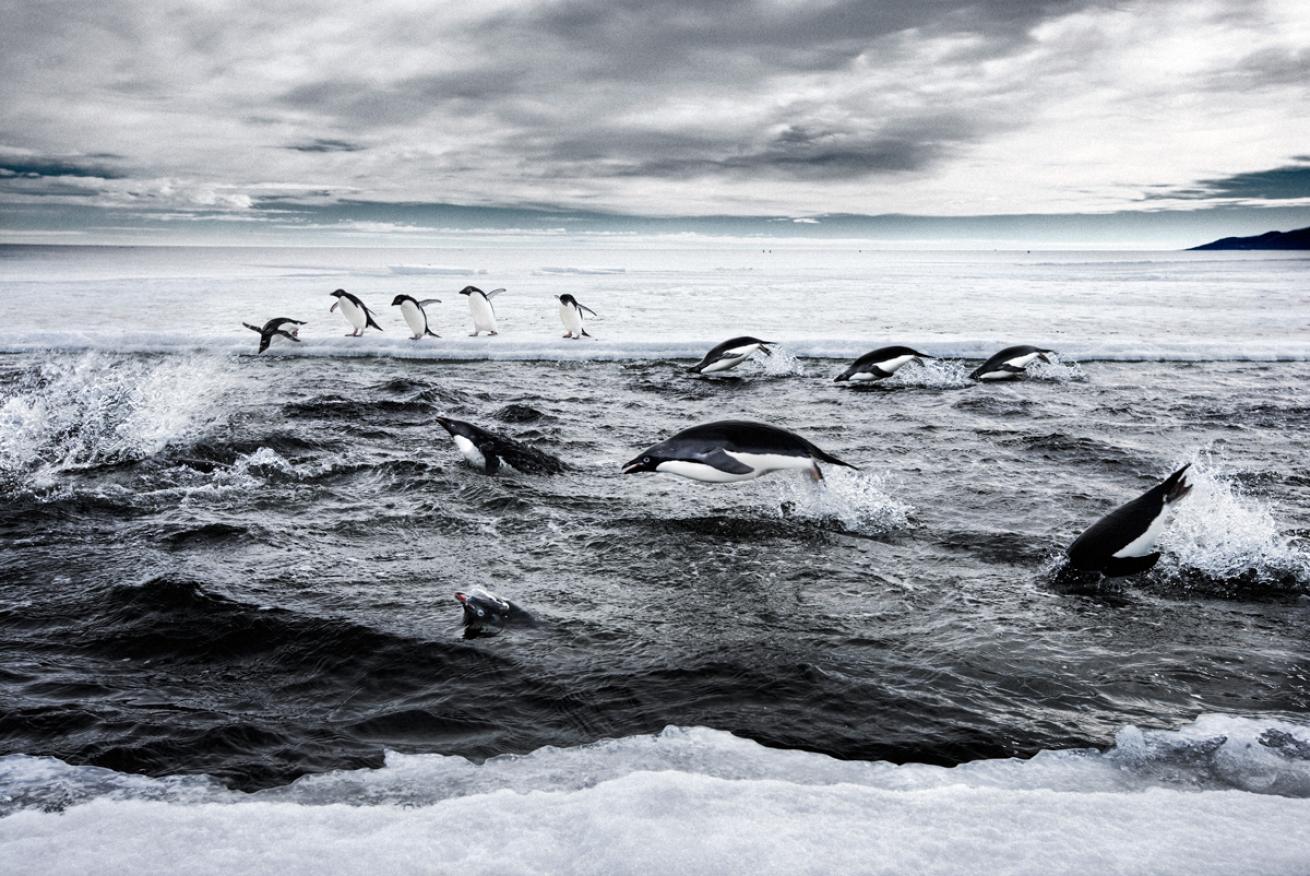
John WellerAdélie penguins hunt in a crack in the sea ice off Cape Royds in McMurdo Sound, Ross Sea.
By then both my wife and I were delegates to CCAMLR through ASOC, so we had access to the closed-door meeting. When the MPA was finally adopted, this room of stoic international diplomats erupted. People were laughing and cheering and crying. Nations were literally hugging other nations. So, I want you to understand that this was not just a massive win for Antarctica or our global oceans. This was also a peace treaty. And it gives me hope that if enough of us speak up and commit ourselves to making a better world for our children, then that is what we can achieve.
Our terrifying current events underscore that we must work together if we are to survive the coming pandemics of a changing climate and fast-disappearing resources. In the long run, the only way to protect Antarctica, and ourselves, is to reduce emissions and keep it frozen. But we must also provide all the protections we can to help these ecosystems adapt. A proposed network of new MPAs in the Southern Ocean would be a necessary quarantine for some of our planet’s most vulnerable. It would be a start in aligning our nations, our cultures and our efforts for our common good. It would be a step forward to ensure a safe, abundant world for our children. It is a chance to accomplish one of the largest acts of conservation in history. It is our global responsibility.
John Weller is a critically acclaimed photographer, writer and filmmaker based in Boulder, Colorado. His work has appeared in magazines including *Outdoor Photographer, American Photo and National Geographic. In 2020 he was named one of Scuba Diving* magazine’s Sea Heroes.
NOW IT’S YOUR TURN: Three More Proposed Antarctic MPAS Need Your Support
We are working closely with partner organizations to achieve global support for three MPA proposals, currently in the midst of multi-year negotiations— in East Antarctica, the Weddell Sea and the Antarctic Peninsula region. If these three were adopted, it would amount to the largest sanctuary in the world, and the greatest act of ocean conservation in history.
Only a few countries remain opposed, and only high-level diplomacy will break the deadlock. Thus, the leaders of supporting countries must make Antarctic MPAs a priority. We must demonstrate that the world is watching and calling for these protections. So how can readers and divers help? Learn more and add your name to our petition at only.one/series/greatestsanctuary.
Join our team, and we will continually connect you to new actions you can take to raise your voice in defense of Antarctica. Together, we can have a real influence on the outcomes—if enough of us speak up.











